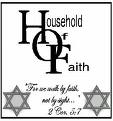| Next | Previous | Index | Tellout Home |
30. Religious Supermarkets
Personal and Particular
 In today's culture, every man and woman in the street has their religious viewpoint, which can be quite different from past generations. Previously, society's norm was a weekly commitment to one Christian denomination and belief in their standards. Dr. Reginald Bibby describes in "Fragmented Gods" this modern view as "religion a la carte," which encompasses the desire to incorporate the beliefs or practices one likes into one's life and ignores the rest. Another term for this phenomenon is "cash and carry Christianity." Many people want to pick and choose from a religious menu depending upon their personal views. They expect a congregation to provide a wedding, funeral, or baptism without any real commitment of time or resources on their part to the church. Some people shop around from church to church to get the best deal and minimum involvement at the lowest cost. They often begin with their denomination then look elsewhere. Beliefs or traditions are usually secondary to an excellent photo opportunity at a wedding! Of prime importance to their choice is that the building picked out for a wedding will look beautiful in the wedding photographs! ✞
In today's culture, every man and woman in the street has their religious viewpoint, which can be quite different from past generations. Previously, society's norm was a weekly commitment to one Christian denomination and belief in their standards. Dr. Reginald Bibby describes in "Fragmented Gods" this modern view as "religion a la carte," which encompasses the desire to incorporate the beliefs or practices one likes into one's life and ignores the rest. Another term for this phenomenon is "cash and carry Christianity." Many people want to pick and choose from a religious menu depending upon their personal views. They expect a congregation to provide a wedding, funeral, or baptism without any real commitment of time or resources on their part to the church. Some people shop around from church to church to get the best deal and minimum involvement at the lowest cost. They often begin with their denomination then look elsewhere. Beliefs or traditions are usually secondary to an excellent photo opportunity at a wedding! Of prime importance to their choice is that the building picked out for a wedding will look beautiful in the wedding photographs! ✞
Various Viewpoints
 Walking into a church like a religious supermarket, some people expect to lift their "rites of passage" needs off the shelf. This kind of consumerism produces enormous problems for the typical congregation. The church traditionally views itself as a social club where members stay and mingle. Society sees it as a corner store to pop into whenever one needs a ceremonial occasion, Christian or otherwise! People make promises to the clergy to receive sacramental or pastoral help and then break them. People don't want the church's social club aspect after all! ✞
Walking into a church like a religious supermarket, some people expect to lift their "rites of passage" needs off the shelf. This kind of consumerism produces enormous problems for the typical congregation. The church traditionally views itself as a social club where members stay and mingle. Society sees it as a corner store to pop into whenever one needs a ceremonial occasion, Christian or otherwise! People make promises to the clergy to receive sacramental or pastoral help and then break them. People don't want the church's social club aspect after all! ✞
Vine and the Branches
An allegory of what the church should be is a series of Christian vine branches that bear much fruit attached to the Jesus trunk. One of the keys to a healthy church is ensuring that each member has a solid attachment to Christ himself. The individual, the church, and its dependent household bodies are linked to Jesus and draw their life from him like Christian vine branches in a growing vine. The New Testament emphasizes this stem, and the members of his body and the limbs. In another analogy, the household is the bride, and Christ is the bridegroom. Again, in a third analogy, the church is the building, and Jesus is the foundation. ✞
The Christ Stem
 Some years ago, my late wife and I were on holiday together with our little daughter, in Folkestone on Britain's South Coast. One evening, as we walked along the sea wall, we saw a vine growing inside a greenhouse. We looked down from the footpath at the greenhouse roof below. A dense mat of vine branches and leaves covered the glass inside. We searched diligently and eventually spotted the vine stem in the greenhouse corner bringing nourishment from the ground. For us, it was a vivid reminder of the special relationship between Christ and his church or the connection between Jesus and his disciples. ✞
Some years ago, my late wife and I were on holiday together with our little daughter, in Folkestone on Britain's South Coast. One evening, as we walked along the sea wall, we saw a vine growing inside a greenhouse. We looked down from the footpath at the greenhouse roof below. A dense mat of vine branches and leaves covered the glass inside. We searched diligently and eventually spotted the vine stem in the greenhouse corner bringing nourishment from the ground. For us, it was a vivid reminder of the special relationship between Christ and his church or the connection between Jesus and his disciples. ✞
Nourishment
In the Household Body, Jesus provides nourishment for Christians who are like vine branches. Jesus said to his disciples in John 15.5-8, "I am the vine, you are the branches. If you remain in me and I in you, you will bear much fruit." Christians, like vine branches, are nurtured by Jesus' trunk to bear fruit. The gardener prunes off any bough, failing to produce fruit to stimulate new growth. He trims dead parts to prevent contamination and disease from spreading to other parts of the plant. As Christians, we are the branches that must produce fruit. If we do not do so, we too are in danger of being pruned off. ✞
Different Church Bodies
 Different church bodies function in the overall mystical body of Christ. Some of these are known as the house church movement. Some of today's largest churches, the so-called "Mega-Churches," are in South Korea and the United States in places like Texas and Florida. Strangely, they can be so successful because they have returned to the Early Church's household principles. In some cases, hundreds of thousands of members rely entirely on small groups meeting in homes. Some of these churches are so large that the congregation rarely gathers together in one place. Congregating together is not essential if the Body of Christ still assembles in household units. Sometimes a quarter of the church meets in the church building once a month! Many of the church members had never met one another! ✞
Different church bodies function in the overall mystical body of Christ. Some of these are known as the house church movement. Some of today's largest churches, the so-called "Mega-Churches," are in South Korea and the United States in places like Texas and Florida. Strangely, they can be so successful because they have returned to the Early Church's household principles. In some cases, hundreds of thousands of members rely entirely on small groups meeting in homes. Some of these churches are so large that the congregation rarely gathers together in one place. Congregating together is not essential if the Body of Christ still assembles in household units. Sometimes a quarter of the church meets in the church building once a month! Many of the church members had never met one another! ✞
Congregating Together
Over the last two thousand years, the church has lost touch with its household roots and evolved into synagogue-type building-based congregations. This approach may have served at other times but not in our current society. The so-called house church movement in Britain attempted to remedy some of the institutional church's inbuilt deficiencies. As offshoots of a local congregation, they started well, and meetings in homes proliferated. However, many became introspective or outgrew their premises and moved back to a church type of building. What goes around, comes around! House churches, when they outgrow their premises, also cannot be divided easily which poses the question, "What effect would it have on your church if you had no church building?" ✞
Small Sized Churches
 Matriarchs and patriarchs often lead small-sized churches. These keep them going and save the institution from oblivion within them. Most of us view the average church like a bus. All the passengers sat in rows facing forward, and a driver steers at the front. Someone even comes and takes your money! This current church model is collapsing in the face of a new culture. Though church growth specialists can help us run what we have better, we should revert to the initial household model for small churches. It would keep Christianity from oblivion, if not our institution. We can realize new growth and vitality in our faith communities. ✞
Matriarchs and patriarchs often lead small-sized churches. These keep them going and save the institution from oblivion within them. Most of us view the average church like a bus. All the passengers sat in rows facing forward, and a driver steers at the front. Someone even comes and takes your money! This current church model is collapsing in the face of a new culture. Though church growth specialists can help us run what we have better, we should revert to the initial household model for small churches. It would keep Christianity from oblivion, if not our institution. We can realize new growth and vitality in our faith communities. ✞
Different Size Churches
Researchers categorize churches according to their size. "Small" congregations are up to fifty worshippers each Sunday, "extended household churches," also called "family churches," generally comprise one large or several small households plus other associated members together. The clergy person is a chaplain in the small-sized church. Trying to wrestle control from a church's natural leaders has defeated many clerics! The matriarchs and patriarchs in small size churches direct policy discreetly themselves. ✞
Household Church Leaders
 Large and small churches with household church leaders function together sometimes with different service times. "Medium-sized" or "Multiple Household" churches generally have between fifty and two hundred congregational members attending worship each Sunday. At least ten families together comprise this worship unit, much like in the ancient synagogue system. The clergy person is considered the household coordinator, who usually are church leaders in various church's life categories. Large churches of over two hundred members have a higher number of households operating side by side. ✞
Large and small churches with household church leaders function together sometimes with different service times. "Medium-sized" or "Multiple Household" churches generally have between fifty and two hundred congregational members attending worship each Sunday. At least ten families together comprise this worship unit, much like in the ancient synagogue system. The clergy person is considered the household coordinator, who usually are church leaders in various church's life categories. Large churches of over two hundred members have a higher number of households operating side by side. ✞
Leadership
The clergy person is more remote in this model but exercises considerable power. Program leaders are essential, and the elders exercise control, tending to set them apart from the ordinary worshipper. Ministry is vested with the program leaders, the senior minister being an overall administrator and the program director. Individual households in a medium or large church may not know one another because they worship at different service times. Household church leaders rely on a group of lay leaders who assist in pastoring each household. Success in developing households lies in the clergy's ability to look beyond the formal institutional grouping. In discovering the actual household units, they can then encourage and support household leaders and development. New households develop as God's opportunity presents itself. ✞
Institutional Christian Church
 The institutional Christian church may or may not contain the Body of Christ. An Eastern mystic commented on our Western Society, "they have the know-how, but do they know why?" Modern men and women in their hyperactivity have forgotten why they have their being. Our institutional Christian church continues to perform the same religious things like services, committees, renting space, and raising funds because they always had, but do they know why? A firm believer in Christian meditation, Padre Pio, also known as Saint Pio of Pietrelcina (1887-1968 AD), stated, "Through the study of books one seeks God, by meditation one finds him." ✞
The institutional Christian church may or may not contain the Body of Christ. An Eastern mystic commented on our Western Society, "they have the know-how, but do they know why?" Modern men and women in their hyperactivity have forgotten why they have their being. Our institutional Christian church continues to perform the same religious things like services, committees, renting space, and raising funds because they always had, but do they know why? A firm believer in Christian meditation, Padre Pio, also known as Saint Pio of Pietrelcina (1887-1968 AD), stated, "Through the study of books one seeks God, by meditation one finds him." ✞
Respect Lacking
No one respects or listens to the institutional church anymore. It is under attack and generally ridiculed in the media and often rightly for its "weird antics." Television portrays clergy as bumbling eggheads or Bible-thumping extremists out of touch with society's needs. Many pastors adopt this kind of caricature themselves, going around in fancy robes and carrying big books. Churches generally react to society's criticism by diluting their standards to accommodate others. Instead of quieting its critics, this only stimulated further attacks and erosion. ✞
Mainline Churches
 Some Mainline churches and their beliefs are often at odds with basic Biblical morals in the Twenty-First Century. In the United States, there are the "Seven Sisters of American Protestantism" - the United Methodist Church, the Evangelical Lutheran Church in America, the Presbyterian Church (USA), the Episcopal Church, the American Baptist Churches, the United Church of Christ, and the Disciples of Christ - as well as the Quakers, Reformed Church in America, African Methodist Episcopal church and other churches. The mainline churches find themselves brushed aside, stripped of their morals, and are weak and deserted by many younger generations. Dr. Reginald Bibby explains, "The majority of young people are sending a sobering message to those who value organized religion. The tough reality facing the country's religious organizations is that the vast majority of youth strongly marginalize religion." ✞
Some Mainline churches and their beliefs are often at odds with basic Biblical morals in the Twenty-First Century. In the United States, there are the "Seven Sisters of American Protestantism" - the United Methodist Church, the Evangelical Lutheran Church in America, the Presbyterian Church (USA), the Episcopal Church, the American Baptist Churches, the United Church of Christ, and the Disciples of Christ - as well as the Quakers, Reformed Church in America, African Methodist Episcopal church and other churches. The mainline churches find themselves brushed aside, stripped of their morals, and are weak and deserted by many younger generations. Dr. Reginald Bibby explains, "The majority of young people are sending a sobering message to those who value organized religion. The tough reality facing the country's religious organizations is that the vast majority of youth strongly marginalize religion." ✞
Real Body of Christ
 The mainline church situation is not hopeless. The solution may not be to abandon the institution but to look again within it for the actual body of Christ which may be embarrassing as we have denied the mystical body's existence for centuries. Turning aside from other concerns, let us devote our energies to the building up of household religion. As in the early days, households of faith are the future hope for the wider mainline churches. The corporate level, the broader denominations' horizons, and the global community of faith that we call Christ's worldwide body face the challenge of being useful and relevant. A great danger for the present church is that it seems intent on upsetting other denominations by ridiculing their beliefs and moving further from Biblical standards in favor of political correctness. Political correctness is never a substitute for Biblical correctness! ✞
The mainline church situation is not hopeless. The solution may not be to abandon the institution but to look again within it for the actual body of Christ which may be embarrassing as we have denied the mystical body's existence for centuries. Turning aside from other concerns, let us devote our energies to the building up of household religion. As in the early days, households of faith are the future hope for the wider mainline churches. The corporate level, the broader denominations' horizons, and the global community of faith that we call Christ's worldwide body face the challenge of being useful and relevant. A great danger for the present church is that it seems intent on upsetting other denominations by ridiculing their beliefs and moving further from Biblical standards in favor of political correctness. Political correctness is never a substitute for Biblical correctness! ✞
"Religious Supermarkets"
by Ron Meacock © 2021
| ^Top Page | Next | Previous |